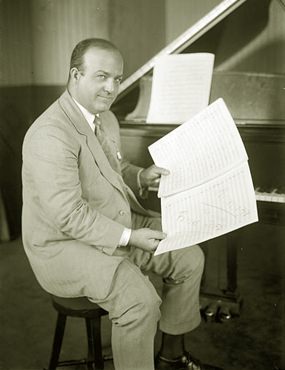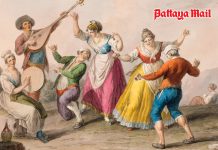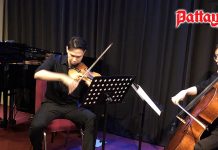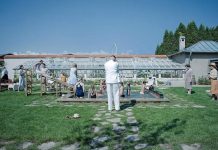Sometime during the 1970s – I am not quite sure exactly when – the Turnabout record label released a pair of vinyl LPs entitled Americana. They contained, as you might reasonably expect, recordings of music deemed to embody the spirit of America or at least, the spirit of rural America a hundred years ago. The works included Men and Mountains by Charles Ruggles, From the Steeples and the Mountains by Charles Ives and Quiet City by Aaron Copland, a piece that for many people has come to symbolize a sleepy town somewhere in the mid-West.
Another American composer, Ferde Grofé – famous for his sound-pictures of the American landscape – wasn’t represented on the recording. Ferdinand Rudolf von Grofé was born in New York into a family of well-established professional musicians. When he was still a child, his mother spirited him off to Germany to study piano, viola and composition in Leipzig, where he also became proficient on a wide range of instruments, a skill which served him well in his later years as a composer and brilliant arranger.
 Ferde Grofé. (Photo/United States Library of Congress)
Ferde Grofé. (Photo/United States Library of Congress)
When Grofé was sixteen years old, he lived in San Francisco and after a succession of dead-end jobs found himself playing piano in a house of ill-repute, supposedly unaware of the lusty and breathless activities going on upstairs. San Francisco was also where the young Grofé first heard jazz. Although there are sometimes jazz influences in the music of Copland especially in the Clarinet Concerto, Grofé absorbed jazz totally. The jazz that excited him relied heavily on improvisation and he became interested in finding ways writing it all down. His arranging skills were eventually noticed by band-leader Paul Whiteman, who in 1924 hired him as pianist and arranger. Grofé orchestrated Gershwin’s Rhapsody in Blue for Whiteman’s orchestra and when the work was adapted for symphony orchestra, again it was Ferde Grofé who took on the job.
Ferde Grofé (1892-1972): Grand Canyon. Walt Disney movie featuring the Graunke Symphony Orchestra cond. Frederick Stark (Duration: 27:42, Video: 480p)
There’s an interesting connection here because like Rhapsody in Blue, the Grand Canyon Suite was originally also written for a small orchestra and also first performed by the Paul Whiteman orchestra. It was only later that Grofé expanded the work for full symphony orchestra. It consists of five movements, each a sound-picture of a particular scene typical of the Grand Canyon. Grofé may have got the first ideas for the work as early as 1916 when he drove across the Arizona desert to watch the sun rise over the Grand Canyon.
In 1958, Walt Disney produced a movie called Grand Canyon employing the recently-invented Cinemascope format and using Grofé’s expansive composition as the sound-track. There is no story and no dialogue but the movie was considered outstanding enough for an Academy Award. Directed by James Algar, it has some fine and original photography and despite its age, it’s a delight to watch.
For some reason, the name of the orchestra is not shown in the opening titles. However, it turns out to be the Graunke Symphony Orchestra, formed in Germany in 1945 and later becoming the Munich Symphony Orchestra. In many ways this is a remarkable work, not least for its superb orchestration.
Aaron Copland (1900-1990): Appalachian Spring. Detroit Symphony Orchestra cond. Leonard Slatkin (Duration: 43:45, Video: 720p HD)
Like the Grand Canyon Suite, this well-known work was originally scored for small orchestra. It was commissioned by the legendary ballet dancer and choreographer Martha Graham and first performed in 1944 at the Library of Congress in Washington D.C.
The ballet tells the story of a spring celebration of nineteenth century American pioneers after having built a new farmhouse in Pennsylvania. The work is full of traditional American themes, including the Shaker song Simple Gifts, which Copland borrowed and wove into the music. You might recognise the tune as the popular hymn Lord of the Dance. Even during the first few moments of the music when stillness prevails, Copland creates a compelling impression of the wide open spaces.
In 1945, the composer arranged the music for symphony orchestra and this is the version usually performed today. For various complicated reasons, there are four published versions of this work but like the Grofé suite, it’s a fine example of orchestration at its best.
Interestingly, when Copland wrote the music, he had no title in mind and simply referred to it as the “Ballet for Martha” but before the first performance, she suggested that the title could be a phrase from a poem by the American poet Harold Hart Crane. The phrase, of course was “Appalachian Spring”. Although the poem is about a journey to meet springtime, the word “spring” in the title refers to a source of water, not to the season. Not many people know that.




